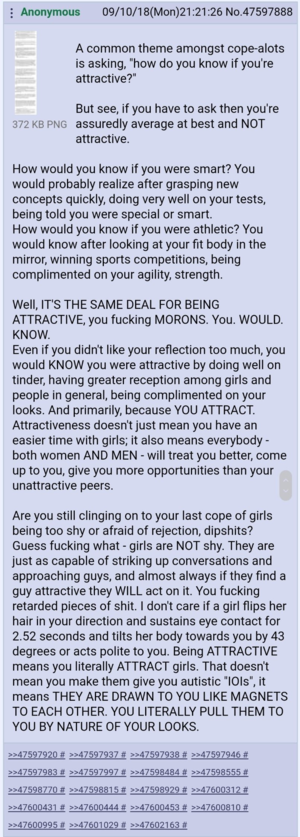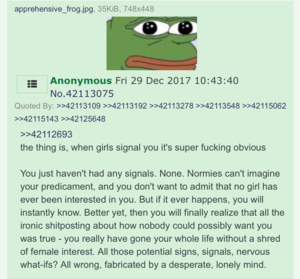Indicator of interest
An indicator of interest, often abbreviated as IOI, is an indicator that a person is interested in you romantically. The term was coined by pick-up artists, who often considered that it was necessary to wait for an IOI from a woman in order to approach her successfully. Thus it follows from this theory that being able to perceive IOIs is an important component of dating success for most men.
There are many variations of IOIs. Not all people who are romantically interested are able to give out IOIs properly due to shyness or other difficulties. In addition, many dating-challenged people claim to not get IOIs often enough, if at all. As female provided IOIs seem vague (perhaps owing to their general tendency towards sexual coyness), in some cases this lack of perceived IOIs can be caused by social deficits that make one unable to recognize them, e.g. those common to people who suffer from autism.
Men, especially those with an unrestricted attitude to sexuality, appear to possess a tendency to over-perceive IOIs when interacting with women in general.[1]
The opposite of an IOI is a fuck-off signal.
Examples[edit | edit source]
Potential examples of IOIs, especially as proposed by the PUA culture:
- A combination of a half-smile and an indirect gaze, the so-called "coy glance" claimed to be a universal female IOI by the late ethnologist, Irenäus Eibl-Eibesfeldt.
- A girl looks at you several times and rapidly looking away after each short glance, particularly when you catch her looking at you.
- A girl exposing her neck conspicuously to you, often while stroking it.
- A girl generally being "touchy" towards you.
- A girl adjusts her hair or grooms herself in your presence for no apparent reason.
- A girl laughs at your jokes, even when they aren't funny.
- A girl physically orients her body towards you, even when her attention is elsewhere.
- A girl giggles for no particularly good reason.
- A girl stares longer than normal, especially when she smiles afterwards.
- A girl asking for you help or assistance.
- A girl lurks in your vicinity.
- A girl teasing you, particularly common among adolescents
- A girl raising her eyebrows for a few seconds and then rapidly lowering them.
The IOI deficiency problem[edit | edit source]
A number of love-shy.com commentators believe that most love shys and incels suffer from a defiency of IOIs, and so when an opportunity finally arises, they are unable to act correctly and thus botch the opportunity due to a lack of prior practice. This is an example of a vicious circle that keeps people incel and love-shy.
Love-shys and IOIs[edit | edit source]
Love shys tend to have as much difficulty responding to IOIs as they do giving them out. For love shys who are able to receive IOIs at a decent rate, this can be psychologically devastating, as they are unable to capitalize on opportunities that are thrust in front of them.
Misinterpretation[edit | edit source]
Some love shys and incels misinterpret ordinary greetings or confuse generic interest from girls as romantic interest. This can be the result of a lack of experience, an inability to correctly read body language, or other factors. On the other hand, genuine romantic interest can be misinterpreted as simple friendliness as well.
Note that females can also misinterpret ordinary greetings or confuse generic interest from males as romantic interest which can lead to misunderstandings and conflict.
Controversy[edit | edit source]
The need for a girl to indicate her interest before you ask her out is controversial. Some claim that all that is needed is to establish a good rapport with a girl beforehand, while others claim that this method consistently results in failure more often than not. Some believe that a definite indicator of interest is needed beforehand, and if the girl is ambiguous it means that she is not interested.
The generation of IOIs ties in with the looks/personality controversy, where some claim that a minimum looks threshold is required to receive enough IOIs to act on them. Others claim that a certain personality type is needed.
Memes[edit | edit source]
See also[edit | edit source]

